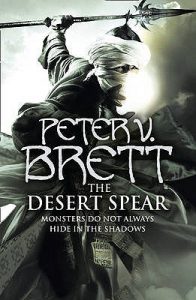The Desert Spear by Peter V. Brett
 I was a little bit apprehensive going into The Desert Spear. I thoroughly enjoyed The Painted Man (book 1 of Brett’s Demon Cycle series), but I’ve heard quite a lot of negative things about the sequels from various people, and at first I really wasn’t sure what to make of it. I initially felt that the complete focus on Jardir’s backstory at the beginning of the book (I think he gets almost 1/3 of the book entirely to himself) stole some of the momentum from the exciting ending built up by the first book, perhaps because I read this so soon after finishing it. I was disappointed not to be reading about Arlen and Leesha, and didn’t like the amount of focus on a character I didn’t really care about and who, until this point, had featured only in a relatively minor fashion.
I was a little bit apprehensive going into The Desert Spear. I thoroughly enjoyed The Painted Man (book 1 of Brett’s Demon Cycle series), but I’ve heard quite a lot of negative things about the sequels from various people, and at first I really wasn’t sure what to make of it. I initially felt that the complete focus on Jardir’s backstory at the beginning of the book (I think he gets almost 1/3 of the book entirely to himself) stole some of the momentum from the exciting ending built up by the first book, perhaps because I read this so soon after finishing it. I was disappointed not to be reading about Arlen and Leesha, and didn’t like the amount of focus on a character I didn’t really care about and who, until this point, had featured only in a relatively minor fashion.
However, once I’d got over myself and stopped sulking, I really started to enjoy learning about Jardir and the Krasians. Some of the Krasian words were a little confusing at first, particularly similar-sounding titles like dama’ting and damaji’ting, but the fact that this part of the story is all one long segment really kept me immersed in the new world, and it all started to make sense very quickly. These origin chapters really help us understand why Jardir does the things he does, and even to sympathise with him (if only a tiny bit), particularly when he is faced with the obstacles of tradition, or being manipulated by the holy women. The author creates a very deep, harsh culture that is both believable and immersive, and does a nice job of portraying lots of different elements of this culture, including marriage, hierarchy and conflict, in an interesting way.
After such a strong focus on Krasia and its alien culture, it was nice to see a return to some of the places I liked best from the first book, such as Miln, Cutter’s Hollow and Tibbet’s Brook. Similarly, returning to the characters of Leesha, Arlen and Rojer was like meeting old friends, and the characters we know and love have developed a little in the time that has passed between the two books. Leesha in particular is much more powerful here, both in regards to her skills and her maturity.
Unlike its predecessors, The Desert Spear does not just centre around three central protagonists. As I’ve already mentioned, there is quite a hefty focus on Ahmann Jardir, as well several additional POV characters: these are introduced well, all of them are relevant and fun to read about, and they also bring even more variety to the existing POVs by giving us a wider view of both conflicts. In addition to the others mentioned, we now see parts of the story through the eyes of the Krasian merchant Abban, Arlen’s childhood sweetheart Renna, and even a mind demon prince from the Core. The POVs are also alternated in a way that keeps our interest, builds tension and compliments the pacing: the character focus tends to change in segments rather than whole chapters (with the exception of Jardir at the beginning), and the occasional rapidly alternating POVs work well to build momentum and work towards interesting convergences.
There are plenty of other things to like about The Desert Spear, but one of my favourites was the introduction of some new species of demon. In addition to flame, rock, wood and sand demons, we now have the terrifying mind demons, who can read thoughts and control people like puppets, and the even more frightening mimic demons, who can assume the physical shape of anything – including humans. I was also gratified to see that some of the things that niggled at me about the first book were actually addressed here, such as what would happen if the demons – who can’t bodily cross the protective wards – realised they were able to throw rocks or other objects at the people hiding behind the wards, and why they don’t do it all the time.
So: having previously heard quite a few negative comments, I was prepared to be disappointed with The Desert Spear . . . but actually, I ended up enjoying it even more than the first book. Bring on The Daylight War!
